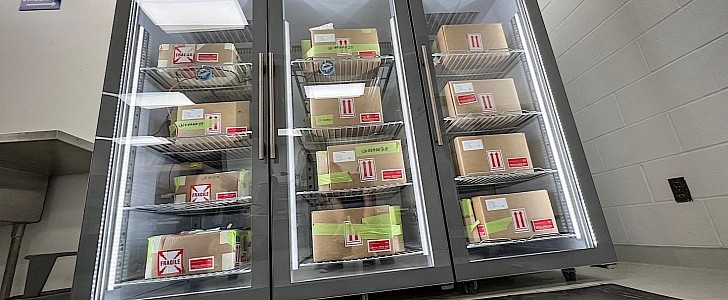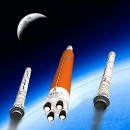When it comes to a piece of technology as complex as the Space Launch System (SLS), a multitude of components must come together in just the right way for everything to work as advertised. In many cases, these components have to be preserved in special conditions even before being integrated, if they are to do their job when the time comes.
Such components are, for instance, the massive rocket’s flight batteries. With the official launch of Artemis I now scheduled for launch sometime in April, they haven’t even been installed in the SLS and won’t be until two days prior to final testing.
Until that time, and probably as a means to stop them from degrading, NASA is keeping the batteries inside a superstore-like glass door refrigerator, wrapped in what appear to be cardboard boxes. The refrigerator, located inside the Flight Battery Shop of the Vehicle Assembly Building at NASA's Kennedy Space Center, keeps the hardware at a crisp 40 degrees Fahrenheit (4.4 degrees Celsius).
We’re not told how many batteries are in each of the cardboard boxes, but we are able to count four rows with three shelves, each packed with them. NASA also doesn’t say how many of the batteries kept in there will make their way onto Artemis I.
That would be the mission that, if successful, should kickstart humanity’s second lunar exploration program, which is hoped will lead to the creation of a space station around the Moon, and possibly even a base on its surface. This outpost would ultimately serve as a staging area for a crewed insertion toward Mars.
Artemis I is an uncrewed flight meant to validate the systems of the SLS rocket and the Orion capsule astronauts will ultimately travel in. Ten small CubeSat pieces of hardware, tasked with various missions, will go along for the ride at least until Earth’s orbit.
Until that time, and probably as a means to stop them from degrading, NASA is keeping the batteries inside a superstore-like glass door refrigerator, wrapped in what appear to be cardboard boxes. The refrigerator, located inside the Flight Battery Shop of the Vehicle Assembly Building at NASA's Kennedy Space Center, keeps the hardware at a crisp 40 degrees Fahrenheit (4.4 degrees Celsius).
We’re not told how many batteries are in each of the cardboard boxes, but we are able to count four rows with three shelves, each packed with them. NASA also doesn’t say how many of the batteries kept in there will make their way onto Artemis I.
That would be the mission that, if successful, should kickstart humanity’s second lunar exploration program, which is hoped will lead to the creation of a space station around the Moon, and possibly even a base on its surface. This outpost would ultimately serve as a staging area for a crewed insertion toward Mars.
Artemis I is an uncrewed flight meant to validate the systems of the SLS rocket and the Orion capsule astronauts will ultimately travel in. Ten small CubeSat pieces of hardware, tasked with various missions, will go along for the ride at least until Earth’s orbit.



















